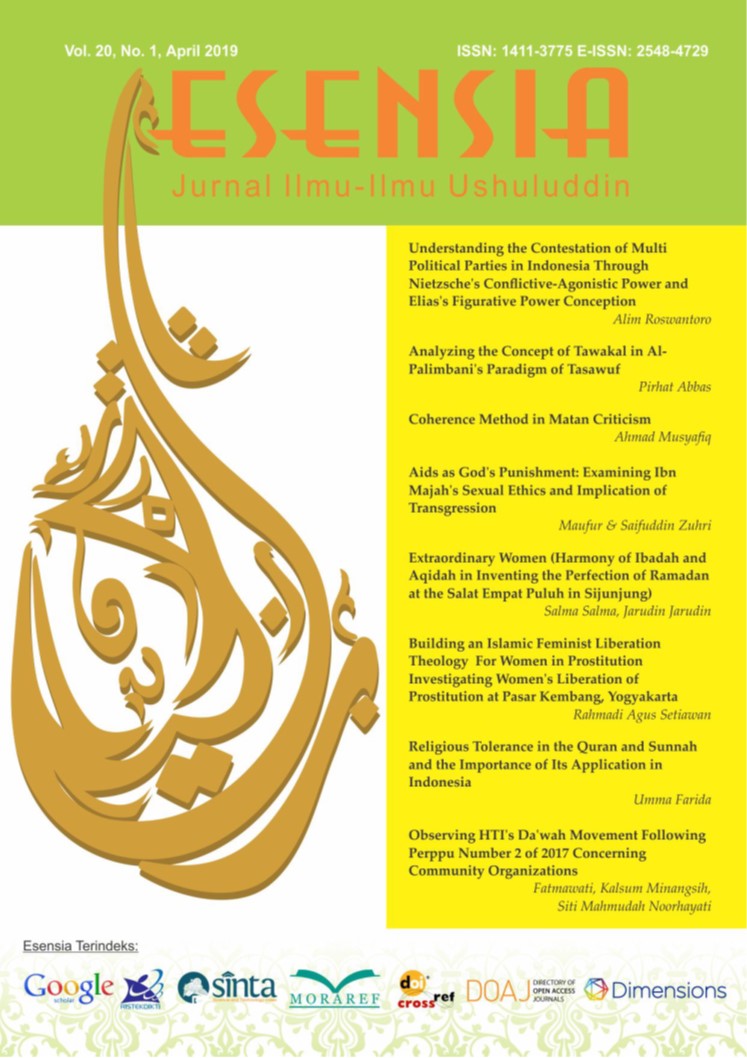Extraordinary Women: (Harmony of Ibadah and Aqidah in Inventing the Perfection of Ramadan at the Salat Empat Puluh in Sijunjung)
Main Article Content
Abstract
Article Details
References
Al-Bukhariy. (1994). Sahih al-Bukhariy. Beirut: Dar al-Fikr.
Aljunied, K. (2018). Not Just a House to Honour God: Mosques in the Malay World as Cosmopolitan Spaces. Gjat, 8 (1).
al-Kasaniy, I. M. (2007). Badai’ al-Sanai’ fi Tartib al-Sharai’. Beirut: Dar al-Fikr.
al-Zuhailiy, W. (1997). al-Fiqh al-Islamiy wa Adillatuhu. Beirut: Dar al-Fikr.
Eltoum, N., Washi, S., & Twaim, A. A. (2014). Dietary Habits and Nutrients Intake of Diabetic Adolescents during Ramadan Fasting. Int. J. Food. Nutrition and Public Health (IJFNPH), 7 (1).
Etemadifar, M., Sayah, F., Alroughani, R., Toghianifar, N., Akbari, M., & Nasr, Z. (2016). Effects of prolonged fasting on fatigue and quality of life in patients with multiple sclerosis. Neurol Sci, 37, 929–933.
Hanani, S. (2016). Perlindungan Perempuan Lanjut Usia Korban Bencana Gempa Bumi melalui Tradisi Sumbayang 40 di Sumatera Barat. Kafa’ah: Jurnal Ilmiah Kajian Gender, VI (1).
Ibrahim, A. R. (2014). The Apprehensions of Traditional Ulama Towards Women’s Participation in Politics in Nigeria. Al-Jāmi‘ah: Journal of Islamic Studies, 52 (2), 331-350.
Ibrahim, I. A., A.Hassan, E., Alkhan, A. M., A.Hussein, M., Ahmed F.Alhabashi, T. Z., Shah, Y. Z., et al. (2018). Ramadan Fasting in Kidney Transplant Recipients: A Single-Centre Retrospective Study. Hindawi Journal of Transplantation, 2018.
Ismail, N. B. (2017). The Qur’anic Exegesis, Reformism, and Women in Twentieth Century Indonesia. Studia Islamika, 24 (3).
Katz, M. H. (2008). Women’s Mawlid Performances In Sanaa and the Construction of Popular Islam. Int. J. Middle East Study, 40, 467–484.
Kiyani, M. M., Memon, A. R., Amjad, M. I., Ameer, M. R., Sadiq, M., & Mahmood, T. (2017). Study of Human Biochemical Parameters During and After Ramadan. J Relig Health, 56, 55–62.
Kool, J., Tong, C., & Turner, B. S. (2008). Women, piety and practice: A study of women and religious practice in Malaysia. Cont Islam, 2, 41-59.
Kul, S., Savas, E., Ozturk, Z. A., & Karadag, G. (2014). Does Ramadan Fasting Alter Body Weight and Blood Lipids and Fasting Blood Glucose in a Healthy Population? A Meta-analysis. J Relig Health, 53, 929–942.
Miles, M. B., & Hubermen, A. M. (1992). Analisis Data Kualitatif. Jakarta: UI Press.
Nair, P. M., & Khawale, P. G. (2016). Role of therapeutic fasting in women’s health: An overview. Journal of Mid-life Health, 7 (2).
Qudamah, I. (2004). al-Mughniy . Beirut: Dar al-Fikr.
Rusyd, I. (1998). Bidayat al-Mujtahid fi Nihayat al-Muqtasid. Kairo: Dar al-Hadis.
Safitri, D. M. (2010). What Went Wrong with The Veil? A Comparative Analysis of the Discourse of the Veil in France, Iran, and Indonesia. Al-Jami‘ah, 48 (1).
Sechzer, J. A. (2004). Islam and Woman: Where Tradition Meets Modernity: History and Interpretations of Islamic Women’s Status. Sex Roles, 51 (5/6).
Siaw, M. Y., Chew, D. E., Dalan, R., Shakoor, S. A., Othman, N., Choo, C. H., et al. (2014). Evaluating the Effect of Ramadan Fasting on Muslim Patients with Diabetes in relation to Use of Medication and Lifestyle Patterns: A Prospective Study. International Journal of Endocrinology .
Sulaiman, S., Quayum, M. A., & Manaf, N. F. (2018). Negotiating Muslim Women’s Rights and Identity in American Diaspora Space: An Islamic Feminist Study of Kahf’s The Girl in the Tangerine Scarf. Kemanusiaan, 25 (1), 43–67.
Thaib, P. R. (2012). Direktori Minangkabau. Batusangkar: Badan Pekerja Pucuak Adat Alam Minangkabau (BP-PAAM).
Umar, M. S. (2007). Gender Issues in Application of Islamic Law in Nigeria. Al-Jami‘ah, 45 (1).
Wahib, A. B. (2017). Being Pious Among Indonesian Salafis. Al-Jāmi‘ah: Journal of Islamic Studies, 55 (1), 1-26.
Zaidan, A. a.-K. (2003). al-Wajiz fi Ushul al-Fiqh. Beirut: Dar al-Fikr.
Zangeneh, F., Yazdi, R. S., Naghizadeh, M. M., & Abedinia, N. (2015). Effect of Ramadan Fasting on Stress Neurohormones in Women with Polycystic Ovary Syndrome. Journal of Family and Reproductive Health, 9 (2).

